engine coolant JEEP GRAND CHEROKEE 2020 Owner handbook (in English)
[x] Cancel search | Manufacturer: JEEP, Model Year: 2020, Model line: GRAND CHEROKEE, Model: JEEP GRAND CHEROKEE 2020Pages: 378, PDF Size: 6.88 MB
Page 53 of 378
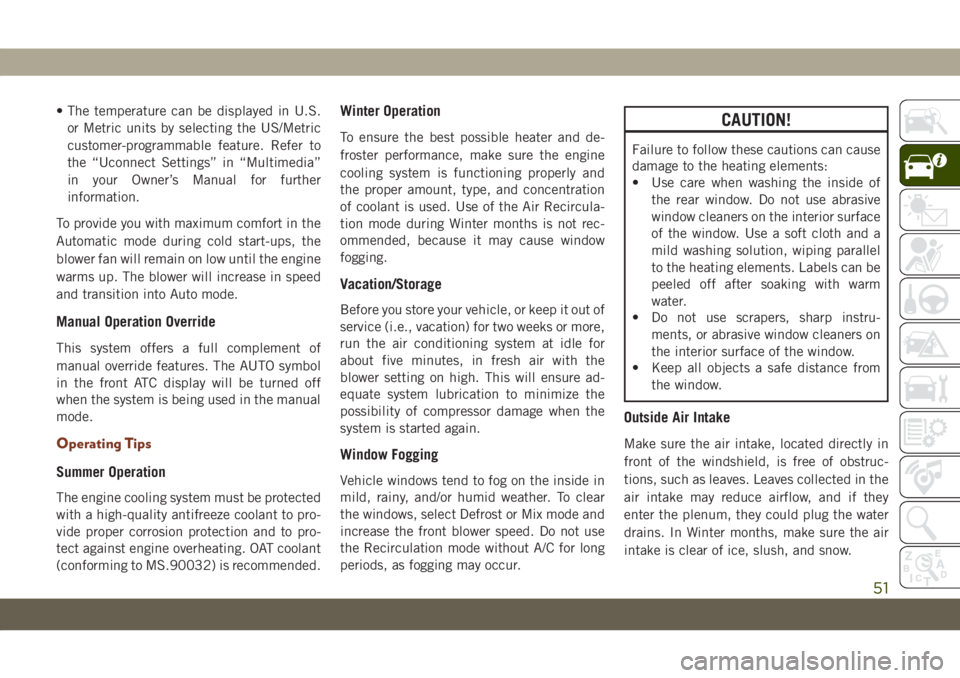
ŌĆó The temperature can be displayed in U.S.
or Metric units by selecting the US/Metric
customer-programmable feature. Refer to
the ŌĆ£Uconnect SettingsŌĆØ in ŌĆ£MultimediaŌĆØ
in your OwnerŌĆÖs Manual for further
information.
To provide you with maximum comfort in the
Automatic mode during cold start-ups, the
blower fan will remain on low until the engine
warms up. The blower will increase in speed
and transition into Auto mode.
Manual Operation Override
This system offers a full complement of
manual override features. The AUTO symbol
in the front ATC display will be turned off
when the system is being used in the manual
mode.
Operating Tips
Summer Operation
The engine cooling system must be protected
with a high-quality antifreeze coolant to pro-
vide proper corrosion protection and to pro-
tect against engine overheating. OAT coolant
(conforming to MS.90032) is recommended.
Winter Operation
To ensure the best possible heater and de-
froster performance, make sure the engine
cooling system is functioning properly and
the proper amount, type, and concentration
of coolant is used. Use of the Air Recircula-
tion mode during Winter months is not rec-
ommended, because it may cause window
fogging.
Vacation/Storage
Before you store your vehicle, or keep it out of
service (i.e., vacation) for two weeks or more,
run the air conditioning system at idle for
about five minutes, in fresh air with the
blower setting on high. This will ensure ad-
equate system lubrication to minimize the
possibility of compressor damage when the
system is started again.
Window Fogging
Vehicle windows tend to fog on the inside in
mild, rainy, and/or humid weather. To clear
the windows, select Defrost or Mix mode and
increase the front blower speed. Do not use
the Recirculation mode without A/C for long
periods, as fogging may occur.
CAUTION!
Failure to follow these cautions can cause
damage to the heating elements:
ŌĆó Use care when washing the inside of
the rear window. Do not use abrasive
window cleaners on the interior surface
of the window. Use a soft cloth and a
mild washing solution, wiping parallel
to the heating elements. Labels can be
peeled off after soaking with warm
water.
ŌĆó Do not use scrapers, sharp instru-
ments, or abrasive window cleaners on
the interior surface of the window.
ŌĆó Keep all objects a safe distance from
the window.
Outside Air Intake
Make sure the air intake, located directly in
front of the windshield, is free of obstruc-
tions, such as leaves. Leaves collected in the
air intake may reduce airflow, and if they
enter the plenum, they could plug the water
drains. In Winter months, make sure the air
intake is clear of ice, slush, and snow.
51
Page 77 of 378
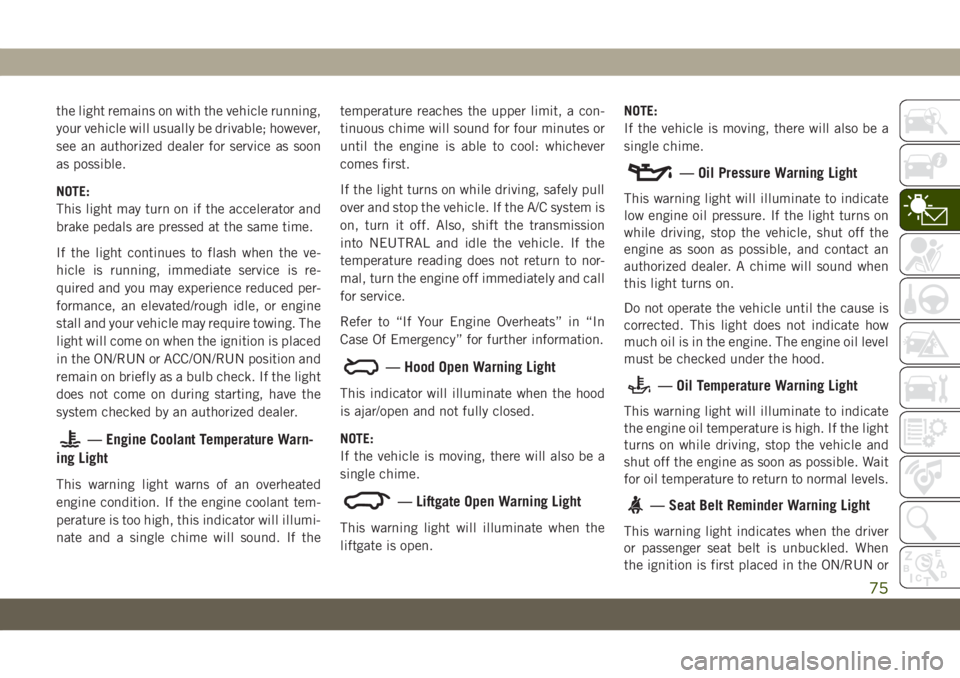
the light remains on with the vehicle running,
your vehicle will usually be drivable; however,
see an authorized dealer for service as soon
as possible.
NOTE:
This light may turn on if the accelerator and
brake pedals are pressed at the same time.
If the light continues to flash when the ve-
hicle is running, immediate service is re-
quired and you may experience reduced per-
formance, an elevated/rough idle, or engine
stall and your vehicle may require towing. The
light will come on when the ignition is placed
in the ON/RUN or ACC/ON/RUN position and
remain on briefly as a bulb check. If the light
does not come on during starting, have the
system checked by an authorized dealer.
ŌĆö Engine Coolant Temperature Warn-
ing Light
This warning light warns of an overheated
engine condition. If the engine coolant tem-
perature is too high, this indicator will illumi-
nate and a single chime will sound. If thetemperature reaches the upper limit, a con-
tinuous chime will sound for four minutes or
until the engine is able to cool: whichever
comes first.
If the light turns on while driving, safely pull
over and stop the vehicle. If the A/C system is
on, turn it off. Also, shift the transmission
into NEUTRAL and idle the vehicle. If the
temperature reading does not return to nor-
mal, turn the engine off immediately and call
for service.
Refer to ŌĆ£If Your Engine OverheatsŌĆØ in ŌĆ£In
Case Of EmergencyŌĆØ for further information.
ŌĆö Hood Open Warning Light
This indicator will illuminate when the hood
is ajar/open and not fully closed.
NOTE:
If the vehicle is moving, there will also be a
single chime.
ŌĆö Liftgate Open Warning Light
This warning light will illuminate when the
liftgate is open.NOTE:
If the vehicle is moving, there will also be a
single chime.
ŌĆö Oil Pressure Warning Light
This warning light will illuminate to indicate
low engine oil pressure. If the light turns on
while driving, stop the vehicle, shut off the
engine as soon as possible, and contact an
authorized dealer. A chime will sound when
this light turns on.
Do not operate the vehicle until the cause is
corrected. This light does not indicate how
much oil is in the engine. The engine oil level
must be checked under the hood.
ŌĆö Oil Temperature Warning Light
This warning light will illuminate to indicate
the engine oil temperature is high. If the light
turns on while driving, stop the vehicle and
shut off the engine as soon as possible. Wait
for oil temperature to return to normal levels.
ŌĆö Seat Belt Reminder Warning Light
This warning light indicates when the driver
or passenger seat belt is unbuckled. When
the ignition is first placed in the ON/RUN or
75
Page 155 of 378
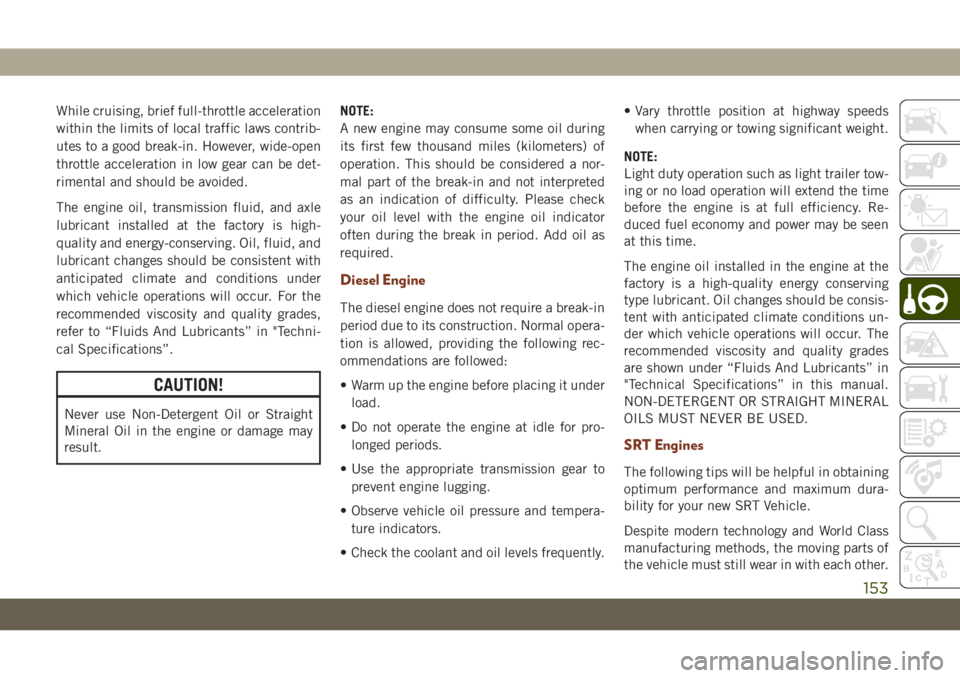
While cruising, brief full-throttle acceleration
within the limits of local traffic laws contrib-
utes to a good break-in. However, wide-open
throttle acceleration in low gear can be det-
rimental and should be avoided.
The engine oil, transmission fluid, and axle
lubricant installed at the factory is high-
quality and energy-conserving. Oil, fluid, and
lubricant changes should be consistent with
anticipated climate and conditions under
which vehicle operations will occur. For the
recommended viscosity and quality grades,
refer to ŌĆ£Fluids And LubricantsŌĆØ in "Techni-
cal SpecificationsŌĆØ.
CAUTION!
Never use Non-Detergent Oil or Straight
Mineral Oil in the engine or damage may
result.NOTE:
A new engine may consume some oil during
its first few thousand miles (kilometers) of
operation. This should be considered a nor-
mal part of the break-in and not interpreted
as an indication of difficulty. Please check
your oil level with the engine oil indicator
often during the break in period. Add oil as
required.
Diesel Engine
The diesel engine does not require a break-in
period due to its construction. Normal opera-
tion is allowed, providing the following rec-
ommendations are followed:
ŌĆó Warm up the engine before placing it under
load.
ŌĆó Do not operate the engine at idle for pro-
longed periods.
ŌĆó Use the appropriate transmission gear to
prevent engine lugging.
ŌĆó Observe vehicle oil pressure and tempera-
ture indicators.
ŌĆó Check the coolant and oil levels frequently.ŌĆó Vary throttle position at highway speeds
when carrying or towing significant weight.
NOTE:
Light duty operation such as light trailer tow-
ing or no load operation will extend the time
before the engine is at full efficiency. Re-
duced fuel economy and power may be seen
at this time.
The engine oil installed in the engine at the
factory is a high-quality energy conserving
type lubricant. Oil changes should be consis-
tent with anticipated climate conditions un-
der which vehicle operations will occur. The
recommended viscosity and quality grades
are shown under ŌĆ£Fluids And LubricantsŌĆØ in
"Technical SpecificationsŌĆØ in this manual.
NON-DETERGENT OR STRAIGHT MINERAL
OILS MUST NEVER BE USED.
SRT Engines
The following tips will be helpful in obtaining
optimum performance and maximum dura-
bility for your new SRT Vehicle.
Despite modern technology and World Class
manufacturing methods, the moving parts of
the vehicle must still wear in with each other.
153
Page 230 of 378
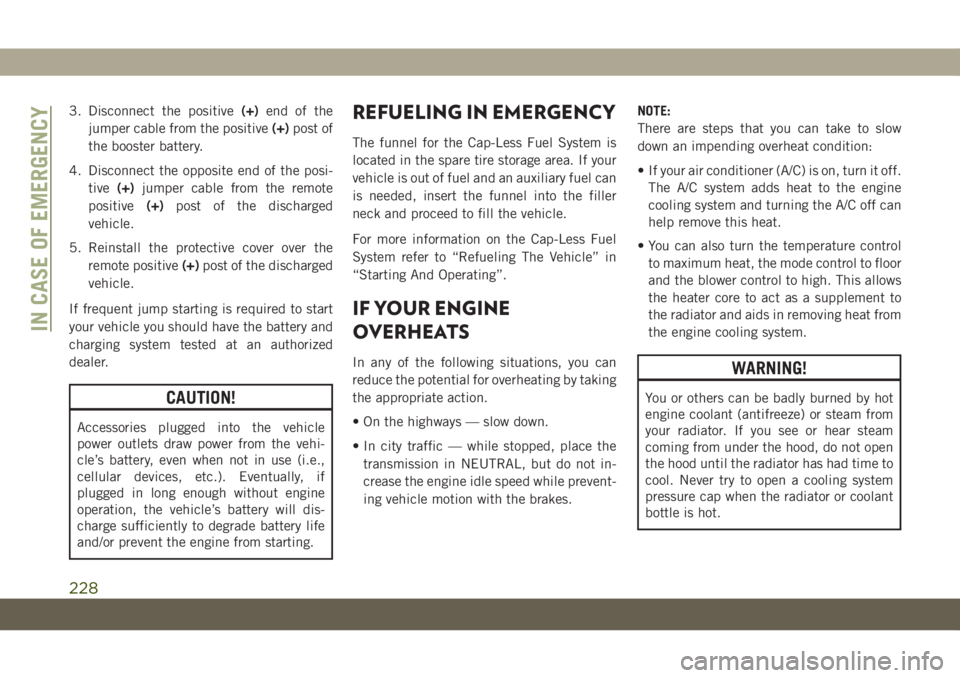
3. Disconnect the positive(+)end of the
jumper cable from the positive(+)post of
the booster battery.
4. Disconnect the opposite end of the posi-
tive(+)jumper cable from the remote
positive(+)post of the discharged
vehicle.
5. Reinstall the protective cover over the
remote positive(+)post of the discharged
vehicle.
If frequent jump starting is required to start
your vehicle you should have the battery and
charging system tested at an authorized
dealer.
CAUTION!
Accessories plugged into the vehicle
power outlets draw power from the vehi-
cleŌĆÖs battery, even when not in use (i.e.,
cellular devices, etc.). Eventually, if
plugged in long enough without engine
operation, the vehicleŌĆÖs battery will dis-
charge sufficiently to degrade battery life
and/or prevent the engine from starting.
REFUELING IN EMERGENCY
The funnel for the Cap-Less Fuel System is
located in the spare tire storage area. If your
vehicle is out of fuel and an auxiliary fuel can
is needed, insert the funnel into the filler
neck and proceed to fill the vehicle.
For more information on the Cap-Less Fuel
System refer to ŌĆ£Refueling The VehicleŌĆØ in
ŌĆ£Starting And OperatingŌĆØ.
IF YOUR ENGINE
OVERHEATS
In any of the following situations, you can
reduce the potential for overheating by taking
the appropriate action.
ŌĆó On the highways ŌĆö slow down.
ŌĆó In city traffic ŌĆö while stopped, place the
transmission in NEUTRAL, but do not in-
crease the engine idle speed while prevent-
ing vehicle motion with the brakes.NOTE:
There are steps that you can take to slow
down an impending overheat condition:
ŌĆó If your air conditioner (A/C) is on, turn it off.
The A/C system adds heat to the engine
cooling system and turning the A/C off can
help remove this heat.
ŌĆó You can also turn the temperature control
to maximum heat, the mode control to floor
and the blower control to high. This allows
the heater core to act as a supplement to
the radiator and aids in removing heat from
the engine cooling system.WARNING!
You or others can be badly burned by hot
engine coolant (antifreeze) or steam from
your radiator. If you see or hear steam
coming from under the hood, do not open
the hood until the radiator has had time to
cool. Never try to open a cooling system
pressure cap when the radiator or coolant
bottle is hot.
IN CASE OF EMERGENCY
228
Page 239 of 378
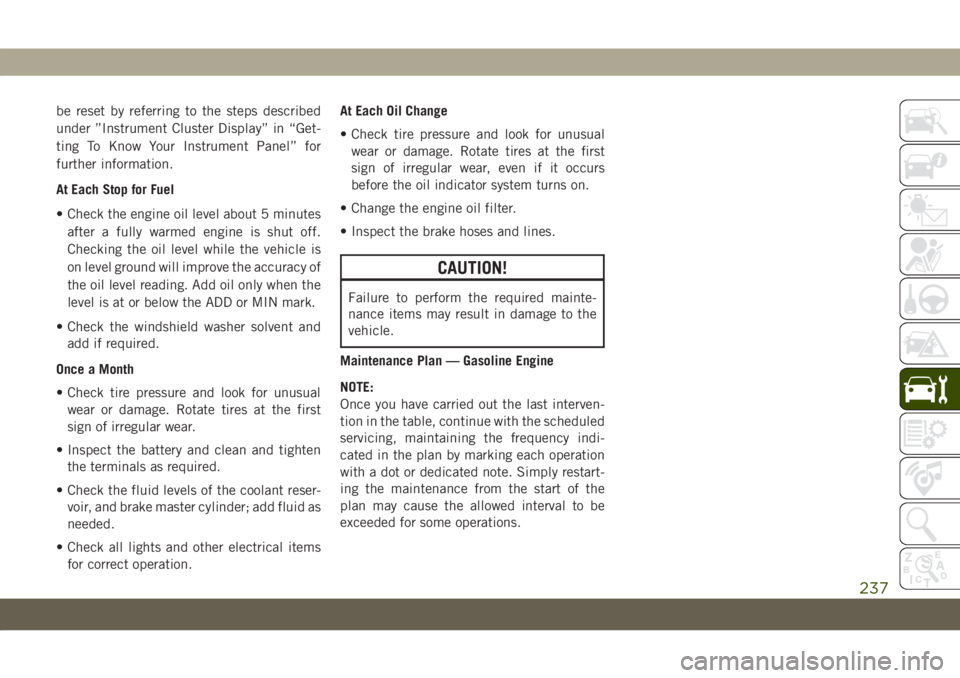
be reset by referring to the steps described
under ŌĆØInstrument Cluster DisplayŌĆØ in ŌĆ£Get-
ting To Know Your Instrument PanelŌĆØ for
further information.
At Each Stop for Fuel
ŌĆó Check the engine oil level about 5 minutes
after a fully warmed engine is shut off.
Checking the oil level while the vehicle is
on level ground will improve the accuracy of
the oil level reading. Add oil only when the
level is at or below the ADD or MIN mark.
ŌĆó Check the windshield washer solvent and
add if required.
Once a Month
ŌĆó Check tire pressure and look for unusual
wear or damage. Rotate tires at the first
sign of irregular wear.
ŌĆó Inspect the battery and clean and tighten
the terminals as required.
ŌĆó Check the fluid levels of the coolant reser-
voir, and brake master cylinder; add fluid as
needed.
ŌĆó Check all lights and other electrical items
for correct operation.At Each Oil Change
ŌĆó Check tire pressure and look for unusual
wear or damage. Rotate tires at the first
sign of irregular wear, even if it occurs
before the oil indicator system turns on.
ŌĆó Change the engine oil filter.
ŌĆó Inspect the brake hoses and lines.
CAUTION!
Failure to perform the required mainte-
nance items may result in damage to the
vehicle.
Maintenance Plan ŌĆö Gasoline Engine
NOTE:
Once you have carried out the last interven-
tion in the table, continue with the scheduled
servicing, maintaining the frequency indi-
cated in the plan by marking each operation
with a dot or dedicated note. Simply restart-
ing the maintenance from the start of the
plan may cause the allowed interval to be
exceeded for some operations.
237
Page 241 of 378
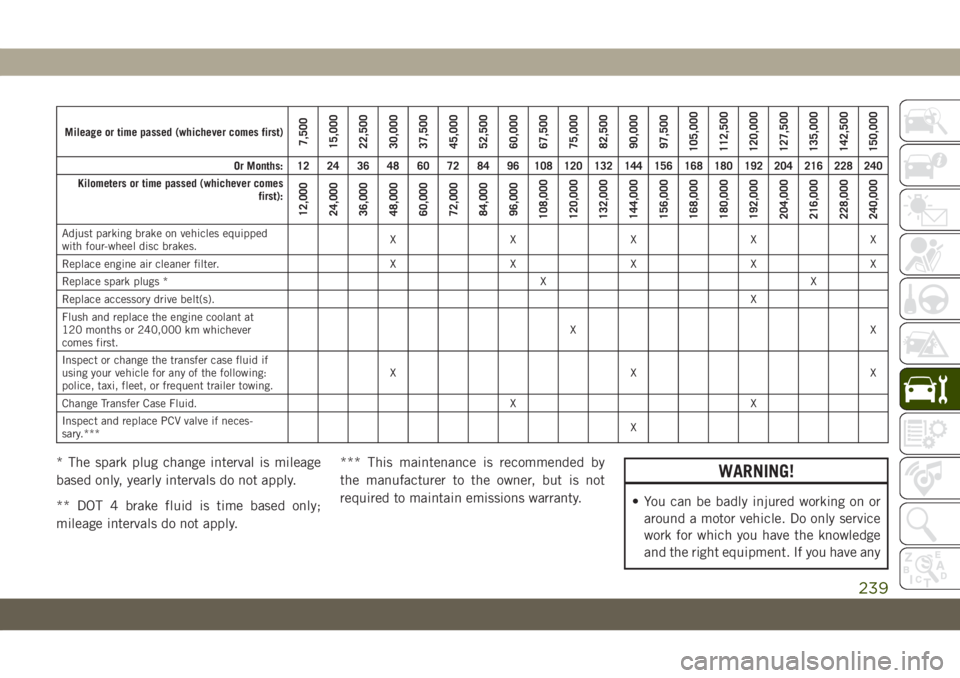
Mileage or time passed (whichever comes first)7,500
15,000
22,500
30,000
37,500
45,000
52,500
60,000
67,500
75,000
82,500
90,000
97,500
105,000
112,500
120,000
127,500
135,000
142,500
150,000
Or Months: 12 24 36 48 60 72 84 96 108 120 132 144 156 168 180 192 204 216 228 240
Kilometers or time passed (whichever comes
first):
12,000
24,000
36,000
48,000
60,000
72,000
84,000
96,000
108,000
120,000
132,000
144,000
156,000
168,000
180,000
192,000
204,000
216,000
228,000
240,000
Adjust parking brake on vehicles equipped
with four-wheel disc brakes.XXXXX
Replace engine air cleaner filter.XXXXX
Replace spark plugs *XX
Replace accessory drive belt(s).X
Flush and replace the engine coolant at
120 months or 240,000 km whichever
comes first.XX
Inspect or change the transfer case fluid if
using your vehicle for any of the following:
police, taxi, fleet, or frequent trailer towing.XXX
Change Transfer Case Fluid. X X
Inspect and replace PCV valve if neces-
sary.***X
* The spark plug change interval is mileage
based only, yearly intervals do not apply.
** DOT 4 brake fluid is time based only;
mileage intervals do not apply.*** This maintenance is recommended by
the manufacturer to the owner, but is not
required to maintain emissions warranty.WARNING!
ŌĆó You can be badly injured working on or
around a motor vehicle. Do only service
work for which you have the knowledge
and the right equipment. If you have any
239
Page 243 of 378
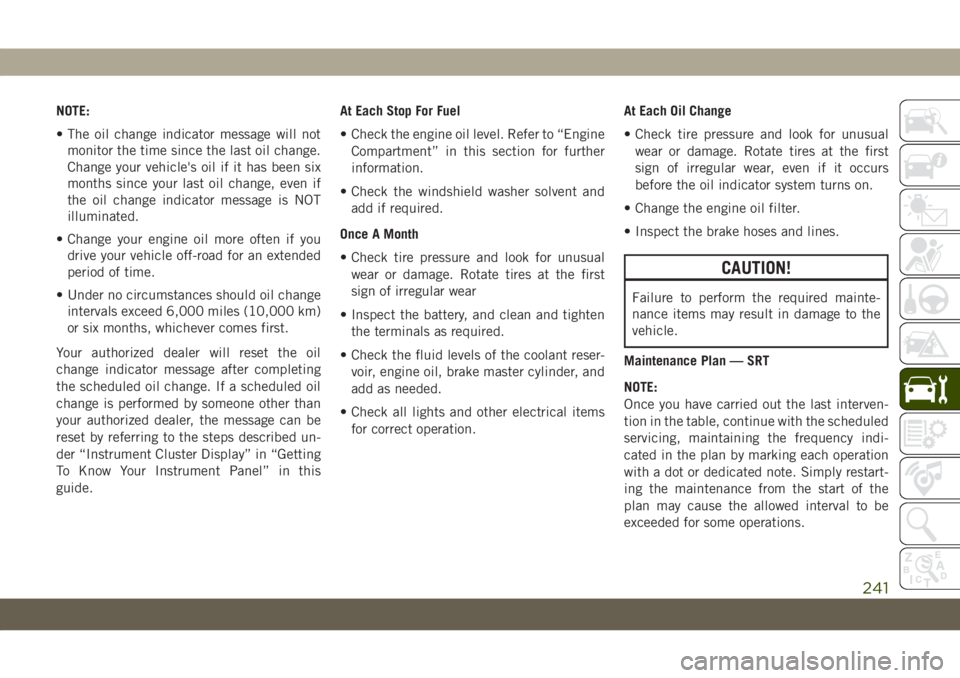
NOTE:
ŌĆó The oil change indicator message will not
monitor the time since the last oil change.
Change your vehicle's oil if it has been six
months since your last oil change, even if
the oil change indicator message is NOT
illuminated.
ŌĆó Change your engine oil more often if you
drive your vehicle off-road for an extended
period of time.
ŌĆó Under no circumstances should oil change
intervals exceed 6,000 miles (10,000 km)
or six months, whichever comes first.
Your authorized dealer will reset the oil
change indicator message after completing
the scheduled oil change. If a scheduled oil
change is performed by someone other than
your authorized dealer, the message can be
reset by referring to the steps described un-
der ŌĆ£Instrument Cluster DisplayŌĆØ in ŌĆ£Getting
To Know Your Instrument PanelŌĆØ in this
guide.At Each Stop For Fuel
ŌĆó Check the engine oil level. Refer to ŌĆ£Engine
CompartmentŌĆØ in this section for further
information.
ŌĆó Check the windshield washer solvent and
add if required.
Once A Month
ŌĆó Check tire pressure and look for unusual
wear or damage. Rotate tires at the first
sign of irregular wear
ŌĆó Inspect the battery, and clean and tighten
the terminals as required.
ŌĆó Check the fluid levels of the coolant reser-
voir, engine oil, brake master cylinder, and
add as needed.
ŌĆó Check all lights and other electrical items
for correct operation.At Each Oil Change
ŌĆó Check tire pressure and look for unusual
wear or damage. Rotate tires at the first
sign of irregular wear, even if it occurs
before the oil indicator system turns on.
ŌĆó Change the engine oil filter.
ŌĆó Inspect the brake hoses and lines.
CAUTION!
Failure to perform the required mainte-
nance items may result in damage to the
vehicle.
Maintenance Plan ŌĆö SRT
NOTE:
Once you have carried out the last interven-
tion in the table, continue with the scheduled
servicing, maintaining the frequency indi-
cated in the plan by marking each operation
with a dot or dedicated note. Simply restart-
ing the maintenance from the start of the
plan may cause the allowed interval to be
exceeded for some operations.
241
Page 245 of 378
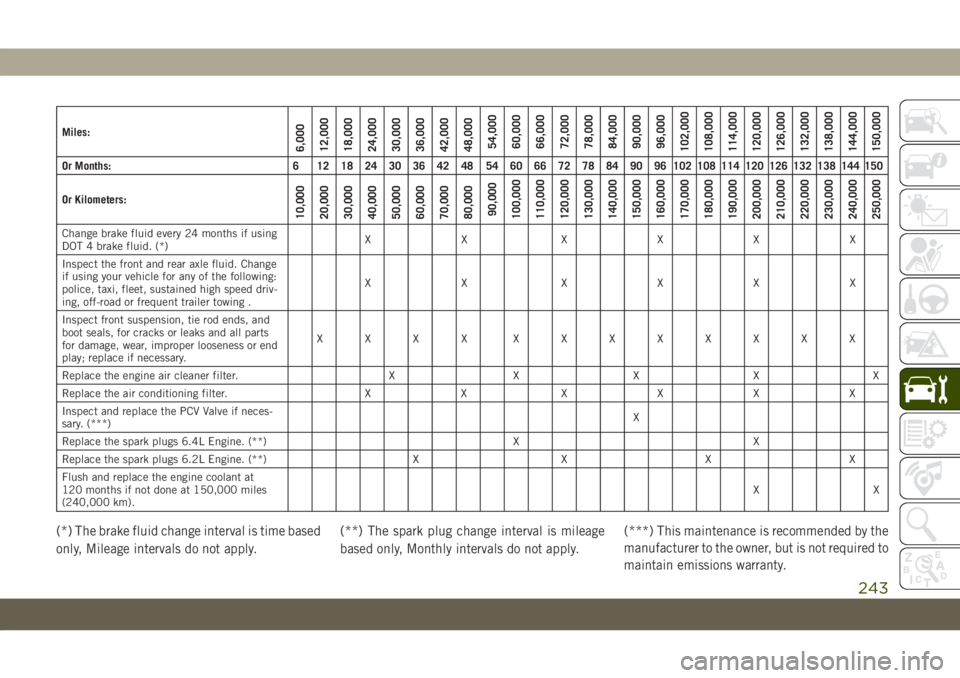
Miles:6,000
12,000
18,000
24,000
30,000
36,000
42,000
48,000
54,000
60,000
66,000
72,000
78,000
84,000
90,000
96,000
102,000
108,000
114,000
120,000
126,000
132,000
138,000
144,000
150,000
Or Months: 6 12 18 24 30 36 42 48 54 60 66 72 78 84 90 96 102 108 114 120 126 132 138 144 150
Or Kilometers:
10,000
20,000
30,000
40,000
50,000
60,000
70,000
80,000
90,000
100,000
110,000
120,000
130,000
140,000
150,000
160,000
170,000
180,000
190,000
200,000
210,000
220,000
230,000
240,000
250,000
Change brake fluid every 24 months if using
DOT 4 brake fluid. (*)XX XXXX
Inspect the front and rear axle fluid. Change
if using your vehicle for any of the following:
police, taxi, fleet, sustained high speed driv-
ing, off-road or frequent trailer towing .XX XXXX
Inspect front suspension, tie rod ends, and
boot seals, for cracks or leaks and all parts
for damage, wear, improper looseness or end
play; replace if necessary.XXXX XXXXXXXX
Replace the engine air cleaner filter. X X X X X
Replace the air conditioning filter. X X X X X X
Inspect and replace the PCV Valve if neces-
sary. (***)X
Replace the spark plugs 6.4L Engine. (**) X X
Replace the spark plugs 6.2L Engine. (**) X X X X
Flush and replace the engine coolant at
120 months if not done at 150,000 miles
(240,000 km).XX
(*) The brake fluid change interval is time based
only, Mileage intervals do not apply.(**) The spark plug change interval is mileage
based only, Monthly intervals do not apply.(***) This maintenance is recommended by the
manufacturer to the owner, but is not required to
maintain emissions warranty.
243
Page 247 of 378
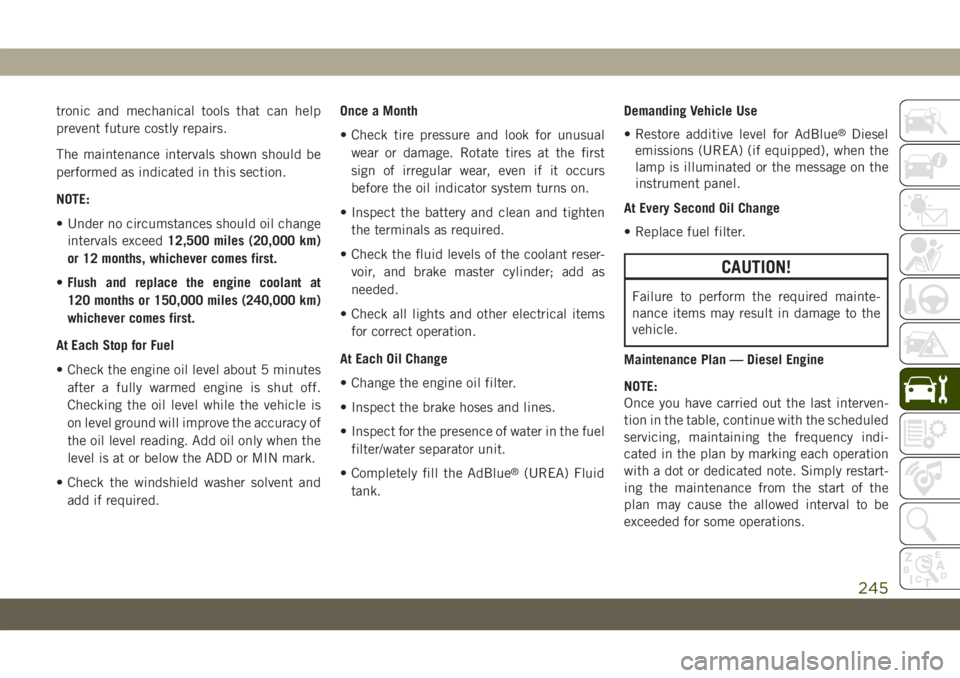
tronic and mechanical tools that can help
prevent future costly repairs.
The maintenance intervals shown should be
performed as indicated in this section.
NOTE:
ŌĆó Under no circumstances should oil change
intervals exceed12,500 miles (20,000 km)
or 12 months, whichever comes first.
ŌĆóFlush and replace the engine coolant at
120 months or 150,000 miles (240,000 km)
whichever comes first.
At Each Stop for Fuel
ŌĆó Check the engine oil level about 5 minutes
after a fully warmed engine is shut off.
Checking the oil level while the vehicle is
on level ground will improve the accuracy of
the oil level reading. Add oil only when the
level is at or below the ADD or MIN mark.
ŌĆó Check the windshield washer solvent and
add if required.Once a Month
ŌĆó Check tire pressure and look for unusual
wear or damage. Rotate tires at the first
sign of irregular wear, even if it occurs
before the oil indicator system turns on.
ŌĆó Inspect the battery and clean and tighten
the terminals as required.
ŌĆó Check the fluid levels of the coolant reser-
voir, and brake master cylinder; add as
needed.
ŌĆó Check all lights and other electrical items
for correct operation.
At Each Oil Change
ŌĆó Change the engine oil filter.
ŌĆó Inspect the brake hoses and lines.
ŌĆó Inspect for the presence of water in the fuel
filter/water separator unit.
ŌĆó Completely fill the AdBlue
®(UREA) Fluid
tank.Demanding Vehicle Use
ŌĆó Restore additive level for AdBlue
®Diesel
emissions (UREA) (if equipped), when the
lamp is illuminated or the message on the
instrument panel.
At Every Second Oil Change
ŌĆó Replace fuel filter.
CAUTION!
Failure to perform the required mainte-
nance items may result in damage to the
vehicle.
Maintenance Plan ŌĆö Diesel Engine
NOTE:
Once you have carried out the last interven-
tion in the table, continue with the scheduled
servicing, maintaining the frequency indi-
cated in the plan by marking each operation
with a dot or dedicated note. Simply restart-
ing the maintenance from the start of the
plan may cause the allowed interval to be
exceeded for some operations.
245
Page 249 of 378
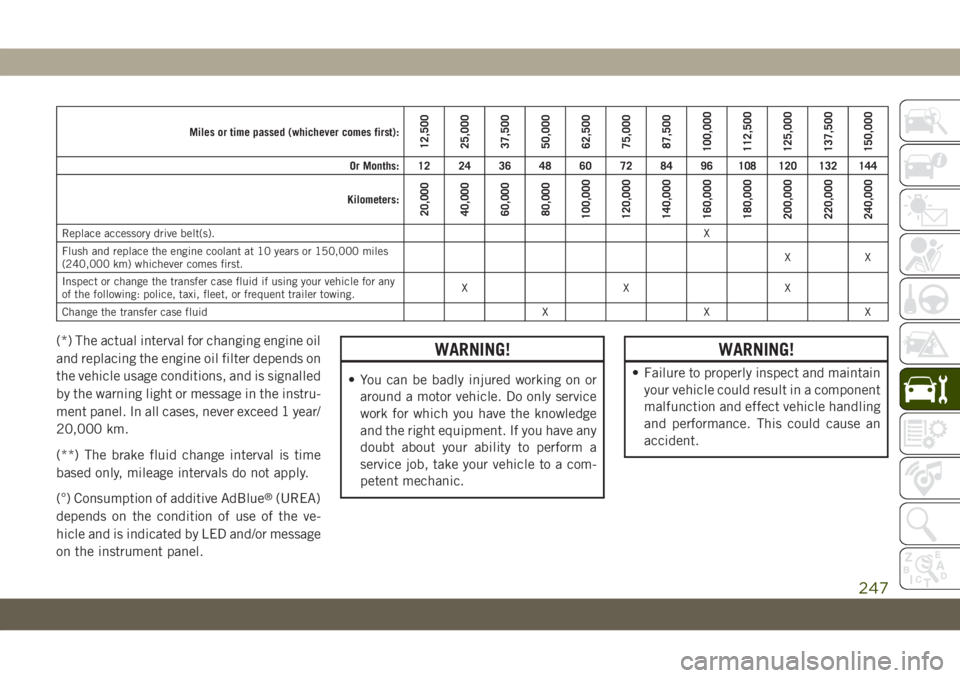
Miles or time passed (whichever comes first):12,500
25,000
37,500
50,000
62,500
75,000
87,500
100,000
112,500
125,000
137,500
150,000
Or Months: 12 24 36 48 60 72 84 96 108 120 132 144
Kilometers:
20,000
40,000
60,000
80,000
100,000
120,000
140,000
160,000
180,000
200,000
220,000
240,000
Replace accessory drive belt(s).X
Flush and replace the engine coolant at 10 years or 150,000 miles
(240,000 km) whichever comes first.XX
Inspect or change the transfer case fluid if using your vehicle for any
of the following: police, taxi, fleet, or frequent trailer towing.XXX
Change the transfer case fluid X X X
(*) The actual interval for changing engine oil
and replacing the engine oil filter depends on
the vehicle usage conditions, and is signalled
by the warning light or message in the instru-
ment panel. In all cases, never exceed 1 year/
20,000 km.
(**) The brake fluid change interval is time
based only, mileage intervals do not apply.
(┬░) Consumption of additive AdBlue
®(UREA)
depends on the condition of use of the ve-
hicle and is indicated by LED and/or message
on the instrument panel.
WARNING!
ŌĆó You can be badly injured working on or
around a motor vehicle. Do only service
work for which you have the knowledge
and the right equipment. If you have any
doubt about your ability to perform a
service job, take your vehicle to a com-
petent mechanic.
WARNING!
ŌĆó Failure to properly inspect and maintain
your vehicle could result in a component
malfunction and effect vehicle handling
and performance. This could cause an
accident.
247